
Italian postcard by C.E. & Co. Photo: Cines. Lyda Borelli in La donna nuda (Carmine Gallone, 1914).
Ma l'amor mio non muore (1914)

Spanish minicard by Reclam Films, Mallorca, no. 1. Photo: Gloria Film. Vittorio Rossi Pianelli as Colonel Julius Holbein, Antonio Monti as The General, and Emilio Petacci as Colonel Theubner in Ma l'amor mio non muore (Mario Caserini, 1913). The Spanish title was ...Pero mi amor no muere.

Spanish minicard by Reclam Films, Mallorca, no. 2. Photo: Gloria Film. Lyda Borelli, Vittorio Rossi Pianelli, and Emilio Petacci in Ma l'amor mio non muore (Mario Caserini, 1913).
She dies on stage in Maximilian's arms
Ma l'amor mio non muore/Love Everlasting (Mario Caserini, 1913) was Lyda Borelli's screen debut. She plays the beautiful Elsa Holbein, who lived in the Grand Duchy of Wallenstein. Elsa is the daughter of Colonel Julius Holbein (Vittorio Rossi Pianelli), who kills himself because he is falsely accused of treason. His missing military plans have been stolen by a foreign spy, Moise Stahr (Gian Paolo Rosmino).
Elsa, although innocent, is exiled and finds refuge on the Riviera. Here she begins to perform on the stage as an opera singer under the pseudonym Diana Cadouleur. Thanks to an engagement by the impresario Schaudard (Camillo De Riso), she achieves great success, but privately, she remains unhappy.
At the height of her success, Elsa meets Prince Maximilian (Mario Bonnard), heir to the Grand Duke, but both don't know each other's true identity. The two fall in love, and Elsa finds happiness, but during a boat trip on the Lago Maggiore, they meet Stahr. Having recognised the woman and been rejected by her, Stahr takes revenge by spreading the news of the Prince's affair, who is called back home.
Elsa, realising Maximilian is the son of the man who expelled her, is devastated. Broken, she returns to Schaudard. Maximilian, contravening the orders of his father, returns to Elsa, but seeing no future for the two of them, Elsa poisons herself and while performing the death scene from 'La Traviata', she collapses and dies on stage in Maximilian's arms.
In addition, Dante Cappelli played the Grand Duke, Maria Caserini the Grandduchess, and Emilio Petacci Colonel Theubner, who is first the close friend of Holbein and Elsa, but then becomes their enemy, acting on behalf of the Grandduke and the General Staff. Angelo Scalenghe was responsible for the cinematography, while the film is remarkable for its deep staging indoor cinematography, especially in the first scene of the film, its outdoor location shooting (around the Italian lakes), the elaborate costumes of Borelli, and its ingenious use of a triple mirror in the dressing room in the second part of the film.
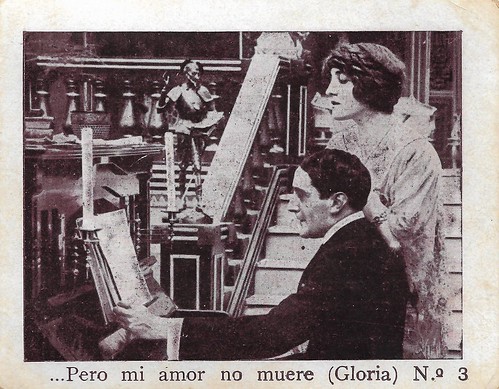
Spanish minicard by Reclam Films, Mallorca, no. 3. Photo: Gloria Film. Lyda Borelli and Mario Bonnard in Ma l'amor mio non muore (Mario Caserini, 1913).
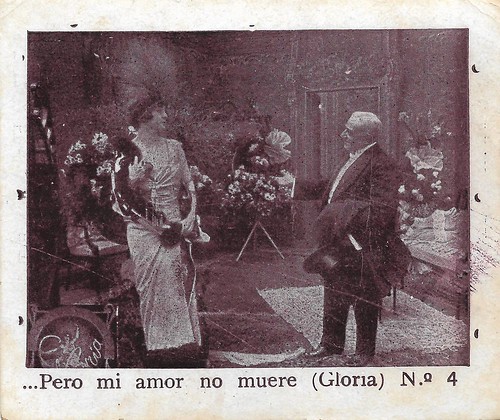
Spanish minicard by Reclam Films, Mallorca, no. 4. Photo: Gloria Film. Lyda Borelli and Camillo de Riso in Ma l'amor mio non muore (Mario Caserini, 1913).
One of the first "noble couples" of Italian cinema
In 1911, one of the most successful Italian silent film directors, Mario Caserini, left Cines for the Turin-based Ambrosio Film. A year later, he broke the contract with the latter as well and participated with the exhibitor Domenico Cazzulino and other partners in the establishment of a new film production company, the Film artistica Gloria.
In the new company Caserini brought with him his wife, the actress Maria Caserini, and a number of actors and actresses he had already directed at Cines and Ambrosio. After making the first two films Il treno degli spettri and Florette e Patapon, Gloria's prospects took off when it managed to recruit one of the most popular theatre actresses of the time, Lyda Borelli, who had never worked in the cinema before.
Caserini then set out to find a suitable subject for Borelli and found it in the writings of two Genoese non-professional authors, Emiliano Bonetti, a doctor, but also a lover of show business and music, and Giovanni Monleone, a teacher and journalist. The two friends had published a few minor works and now had decided to start writing for the cinema, insisting on sentimental and romantic themes. On this occasion, they created a story to which they gave a title taken from the last verse of Puccini's 'Manon Lescaut'.
Ma l'amor mio non muore/Love Everlasting was made in the middle of 1913 in the Turin factory of Gloria in Via Quittengo, where the newcomer Borelli was joined by an already experienced film actor, Mario Bonnard. They formed with one of the first "noble couples" of Italian cinema. Bonnard, however, found himself surpassed in notoriety and public passion, bordering on fanaticism, by the actress, who, according to a repetitive cliché of the "divas", also represents, in this case, a woman destined to die by suicide or to be the cause of death. Some scenes of passionate kissing between the two performers were nevertheless eliminated by the censors.
From the moment it appeared, Ma l'amor mio non muore was a triumphant success, contributing to the creation of the divine myth of Borelli. The periodicals of the time praised it as "the first film which, for the luxury of its staging, the vastness of its scenery and the impeccability of its interpretation, makes one forget the cinema and gives the impression of a work of dramatic art". Praise was lavished. Ma l'amor mio non muore was described as "harmonious, soft: from the small scenes with the faintest effect to the marvelous salons, the luxuriant exteriors, the mysterious landscapes, and the poetic, evocative close-ups", while Borelli was described as "a soft, elegant creature, ardent and painful, cloaked in nobility and voluptuousness, passing like a spring dress through a wood of flowering almond trees".
The writer Matilde Serao was also enthusiastic: "Never as in this film - she wrote - so tender and dramatic, so sumptuous and elegant, has Borelli achieved such a truth of physiognomy, all so differently beautiful". The film was also a commercial success as it was exported all over the world and the authors had news of successful performances for a long time, even from places as far away as Melbourne or La Paz. In later decades, critics and audiences were less enthusiastic, but when in 2013, exactly one century after its release, the film was restored by the Cineteca di Bologna in collaboration with the Museo Nazionale del Cinema di Torino, and shown at the Cinema Ritrovato film festival, the film was praised all over again. This restored edition has been available on DVD since 2013 as part of the Cineteca's series called Cinemalibero.

Spanish minicard by Reclam Films, Mallorca, no. 5. Photo: Gloria Film. Lyda Borelli and Mario Bonnard in Ma l'amor mio non muore (Mario Caserini, 1913).

Spanish minicard by Reclam Films, Mallorca, no. 6. Photo: Gloria Film. Lyda Borelli and Mario Bonnard in Ma l'amor mio non muore (Mario Caserini, 1913).
La memoria dell'altro (1914)
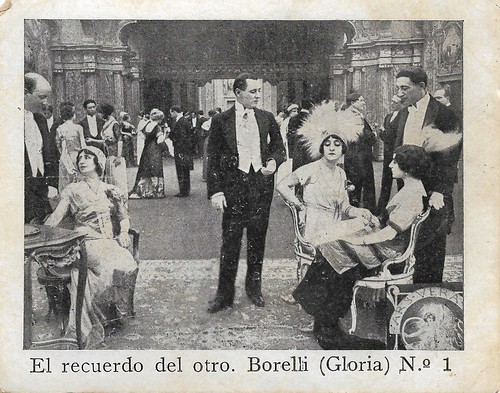
Spanish minicard (collectors card) by Reclam Films, Mallorca, no. 1 of 6 cards. Photo: Gloria Film. Lyda Borelli and Vittorio Rossi Pianelli in La memoria dell'altro (Alberto Degli Abbati, 1914). The Spanish release title was El recuerdo del otro.
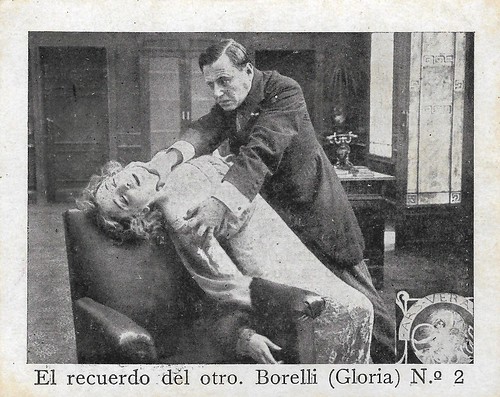
Spanish minicard (collectors card) by Reclam Films, Mallorca, no. 2 of 6 cards. Photo: Gloria Film. Lyda Borelli and Vittorio Rossi Pianelli in La memoria dell'altro (Alberto Degli Abbati, 1914).
Her memory of Mario as her final vision
Just a few months after the release of Ma l’amor mio non muore! (Mario Caserini, 1913) followed Alberto Degli Abbati’s La memoria dell’altro/Memory of the other (1914), in which Lyda Borelli starred again with Mario Bonnard. La memoria dell’altro was made in the wake of the enormous success of its predecessor.
The two Gloria productions, both shot in Turin, became categorised as the first of “the Lyda Borelli series”, although immediately after La memoria dell’altro was finished Borelli left Gloria. She would hence continue her career at the Roman Cines company.
Lyda Borelli plays the young aviatrix Lyda, who spurns the advances of the Prince of Sèvre (Vittorio Rossi Pianelli). She falls in love with the journalist Mario (Mario Bonnard), who, although engaged to Cesarina (Letizia Quaranta), goes to Lyda’s home for an assignation. Cesarina sees them and manages to persuade Mario to leave Lyda.
Now alone, Lyda accepts the Prince’s advances even if she cannot forget Mario. Sometime later in Venice, the star-crossed lovers meet by chance in a theatre, re-igniting their memoria and their old love in a succession of romantic scenes.
The Prince goes berserk when he finds out. Yet, when Mario and Lyda have fled to Paris, Mario becomes ill and money runs out. Lyda first sells all of her belongings. Finally, she has to dance for money in a tavern, in order to get money for her beloved. But the medicine, alas, arrives too late. She becomes ill herself, dying in a hospital with her memory of Mario as her final vision.
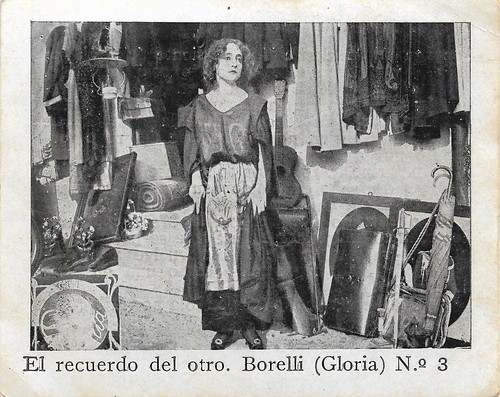
Spanish minicard (collectors card) by Reclam Films, Mallorca, no. 3 of 6 cards. Photo: Gloria Film. Lyda Borelli in La memoria dell'altro (Alberto Degli Abbati, 1914).
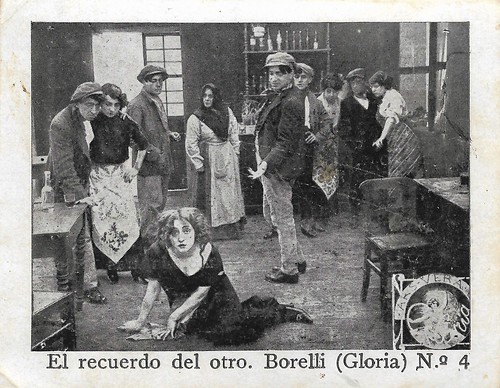
Spanish minicard (collectors card) by Reclam Films, Mallorca, no. 4 of 6 cards. Photo: Gloria Film. Lyda Borelli in La memoria dell'altro (Alberto Degli Abbati, 1914).
A complex, articulate picture of the human heart
La memoria dell'altro/Memory of the other (Alberto Degli Abbati, 1914) was written by Gloria company author Baroness Vittorina De Rege. Marcello Seregni in the festival catalogue of Giornate del Cinema Muto 2018: "The story has the sure ability to create a complex, articulate picture of the human heart.
Lyda’s character glows with sensuality, and the story gives more than a nod to women’s emancipation, with the magnificent opening scene of an airplane in flight, a metaphor for modernity, just as the power and abandon of the apache dance in the second part of the film confirm the independence of the female character."
Mario Bonnard partners Borelli elegantly, providing a perfect counterbalance for the actress’s exuberance, and giving the performance of a “highly effective actor, at the same time sober, measured, and honest”.
Bonnard is there, in the scene, but we could almost say that he isn’t; his most obvious trademark is the extreme flexibility – one critic called it camouflage – with which he enters the shot and performs his role without excess, but with distinction. This second appearance confirmed Bonnard’s skill in evoking the cliché of the tragic male; yet despite its success, he had the wisdom to part company with such type-casting later in his career.
Adding to the film’s success were the Venice locations, among them vaporetto trips and wonderful shots of the Piazza San Marco. The direction was in the capable hands of the versatile Alberto Degli Abbati.

Spanish minicard (collectors card) by Reclam Films, Mallorca, no. 5 of 6 cards. Photo: Gloria Film. Lyda Borelli and Mario Bonnard in La memoria dell'altro (Alberto Degli Abbati, 1914).
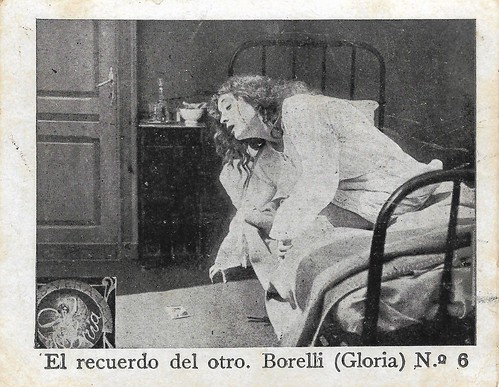
Spanish minicard (collectors card) by Reclam Films, Mallorca, no. 6 of 6 cards. Photo: Gloria Film. Lyda Borelli in La memoria dell'altro (Alberto Degli Abbati, 1914).
La donna nuda (1914)
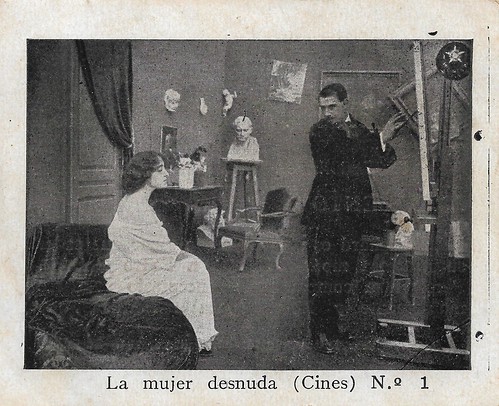
Spanish minicard (collectors card) by Reclam Films, Mallorca, no. 1 of 6 cards. Photo: Cines. Lyda Borelli and Lamberto Picasso in La donna nuda (Carmine Gallone, 1914).
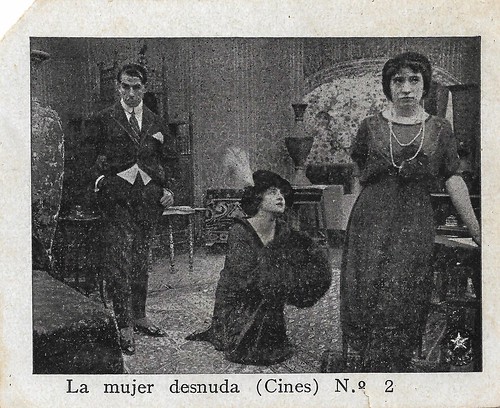
Spanish minicard (collectors card) by Reclam Films, Mallorca, no. 2 of 6 cards. Photo: Cines. Lamberto Picasso, Lyda Borelli, and Wanda Capodaglio in La donna nuda (Carmine Gallone, 1914).
Walking through an autumnal forest with leaves falling down
La donna nuda (Carmine Gallone, 1914) was one of the many film adaptations of Henry Bataille's stage play 'La femme nue'. The painter Pierre Bernier (Lamberto Picasso) becomes rich and famous thanks to the portrait 'The Naked Woman'.
The portrait represents his model, the seductive Lolette (Lyda Borelli), whom he has 'stolen' from his old master Rouchard (Ugo Piperno). The very evening of his triumph at the Salon des Expositions, he decides to marry her.
But, having become rich and famous, Pierre Bernier soon falls in love with the frivolous Princess of Chaban (Wanda Capodaglio), an amateur painter herself, and abandons the woman to whom he owes his success.
Lolette first implores the princess to give him up, but when she sees her embracing Pierre during a party at her own home, she goes hysterical, throws away her ring, and collapses.
She ends up in hospital where Pierre visits her, but she cannot forgive him. Deluded, she returns to Rouchard walking through an autumnal forest, with leaves falling down around her. When Pierre understands the princess is not in love with him, he asks Lolette to forgive him. Poor Rouchard, hopelessly in love with Lolette, will remain alone.

Spanish minicard (collectors card) by Reclam Films, Mallorca, no. 3 of 6 cards. Photo: Cines. Lyda Borelli in La donna nuda (Carmine Gallone, 1914).
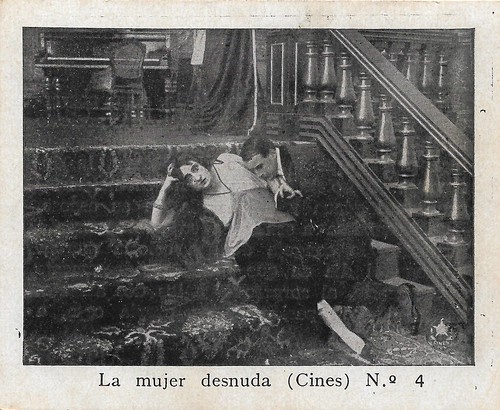
Spanish minicard (collectors card) by Reclam Films, Mallorca, no. 4 of 6 cards. Photo: Cines. Lyda Borelli, and Lamberto Picasso, in La donna nuda (Carmine Gallone, 1914).
One of Borelli's most outstanding performances
La donna nuda (1914)was Lyda Borelli's first production for the Roman company Cines, after her first two films at the Turinese company Gloria. Yet, the exteriors of the film were shot at the Valentino park in Turin.
The film had its Italian premiere in April 1914 and became a worldwide success. Even if some critics thought her earlier film Ma l'amor mio non muore a better film, the film critic Max wrote from Turin a raving review for the Neapolitan journal Film, considering it one of Cines' best films and one of Borelli's most outstanding performances, even if her comic moments were not really appreciated.
Even if a little astray boy risks ruining it, the shot in the autumnal forest is worthy of its sound equivalent at the end of The Third Man (Carol Reed, 1949) with Alida Valli.
Also, the shot through the half opaque glass during the ball, when Lolette witnesses the adultery, is masterfully done. Otherwise, the cinematography is static and it is rather the mise-en-scene that draws the attention, such as the deep staging interior scenes, or a back-lit shot on a bridge at the Valentino.
Lamberto Picasso is not very convincing as Pierre Bernier and while helping Lolette after her big scene of hysteria, he remarkable often holds his hands at her bosom. More touching is Ugo Piperno as the old painter who in the end loses Lolette, while being the more honest, loyal, and sincerely loving man.
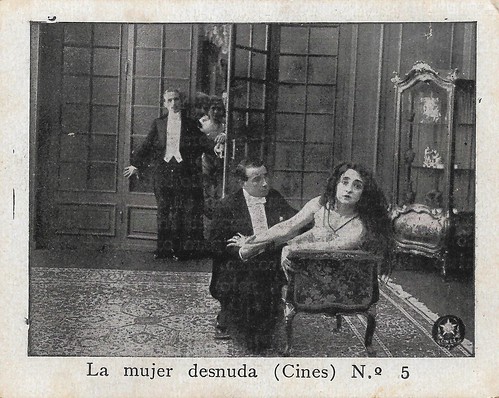
Spanish minicard (collectors card) by Reclam Films, Mallorca, no. 5 of 6 cards. Photo: Cines. Lyda Borelli, and Lamberto Picasso, in La donna nuda (Carmine Gallone, 1914).
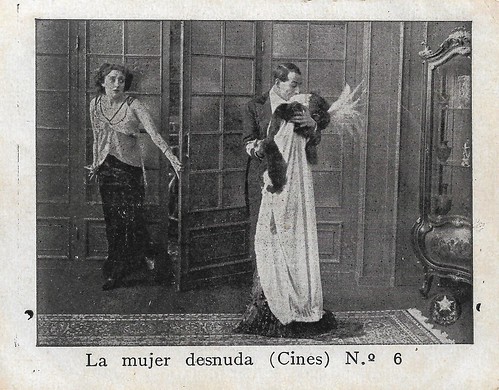
Spanish minicard (collectors card) by Reclam Films, Mallorca, no. 6 of 6 cards. Photo: Cines. Lyda Borelli, Lamberto Picasso, and Wanda Capodaglio in La donna nuda (Carmine Gallone, 1914).
Sources: Marcello Seregni (Catalogue Giornate del Cinema Muto, 2018), Wikipedia (Italian), IMDb, and viewing of the films.
No comments:
Post a Comment